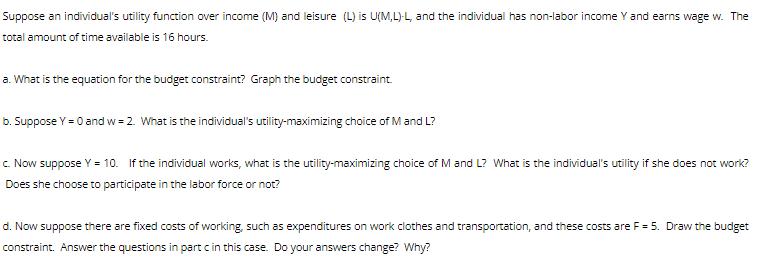Answered step by step
Verified Expert Solution
Question
1 Approved Answer
Suppose an individual's utility function over income (M) and leisure (L) is U(M,L)-L, and the individual has non-labor income Y and earns wage w.
Suppose an individual's utility function over income (M) and leisure (L) is U(M,L)-L, and the individual has non-labor income Y and earns wage w. The total amount of time available is 16 hours. a. What is the equation for the budget constraint? Graph the budget constraint. b. Suppose Y = 0 and w = 2. What is the individual's utility-maximizing choice of M and L? c. Now suppose Y = 10. If the individual works, what is the utility-maximizing choice of M and L? What is the individual's utility if she does not work? Does she choose to participate in the labor force or not? d. Now suppose there are fixed costs of working, such as expenditures on work clothes and transportation, and these costs are F = 5. Draw the budget constraint. Answer the questions in part c in this case. Do your answers change? Why?
Step by Step Solution
There are 3 Steps involved in it
Step: 1
a The budget constraint equation can be written as M wL Y w16L where M is income from labor w is the ...
Get Instant Access to Expert-Tailored Solutions
See step-by-step solutions with expert insights and AI powered tools for academic success
Step: 2

Step: 3

Ace Your Homework with AI
Get the answers you need in no time with our AI-driven, step-by-step assistance
Get Started



